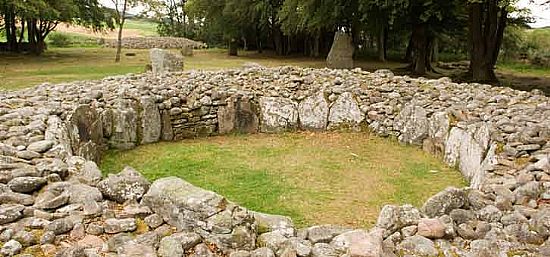Strathnairn Archaeology
ARCHAEOLOGICAL SITES IN STRATHNAIRN
Dr Arthur Bennet, Farr, has written this short account of the archaeology of Strathnairn -
the whole area is full of these sites, some of them of national importance,
deserving a book to themselves.
The evidence of the presence of ancient peoples is plentiful and widely distributed in Strathnairn. There are sites which have been much studied and described and others which remain to be recorded in detail.
At Clava, are the remains of Chambered Cairns of a type unique to this area. They are located at map reference 756 444, grouped within a small area, along with a fine ring of Standing Stones. At the same site are examples of Cup-Marked Stones, a feature which is found over a much wider area of Scotland and which has given rise to much interest and speculation because the purpose of these artificially made hollows in large stones is not clearly obvious.
Further rings of standing stones are to be seen at 680 335 and at 679 359, so that one can conclude that the social culture of the area in those times must have placed great importance on stone circles as they could not have been made without devoting much of the community?s resources to the project over a long period of time.
Notable among the many other archeological remains in the area are Carn Glas, a triple chambered cairn at 650 384, and a crannog at 603 276. Hut circles and field systems abound throughout the Strath making it clear that it must have been possible to win a living out of the soil in these parts more readily in those times. We are left wondering whether the climate was then more favourable or was it just that people were willing to suffer greater hardship?
A hill fort at 600 316 is in an impressive commanding situation, and is cognate with nearby hill forts at Inverfarigaig, and Bunloit, across Loch Ness.
Among the more recent remains of interest are old water mills on the Nairn below Kilravock and several quern stones found around the smaller old settlements. One wonders if they were concealed to avoid the outlawing of the practice of grinding ones own grain at home which was undermining the establishment of the new large water mills, where a payment had to be made for the services of the miller, often part of the harvest. There are also many ruined houses, some which can still be associated with place-names, reminders of the steady efflux of the rural population over the past 250 years, to the towns and to U.S.A., Canada, Australia, etc. sometimes voluntarily, sometimes under duress.

Clava Chambered Cairns